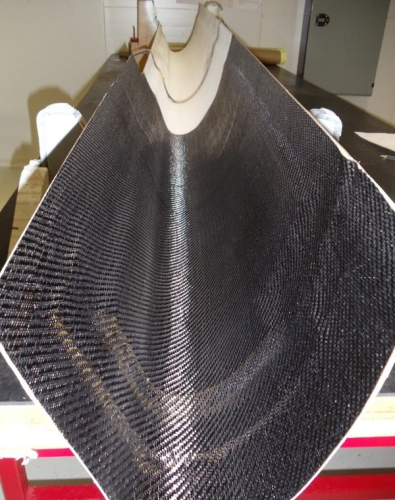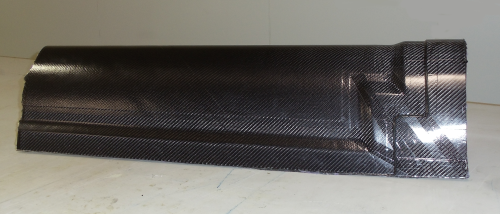


An ongoing challenge for aviation maintenance, repair and overhaul (MRO) service providers is how to make durable low temperature cure tooling easily and cost effectively suitable for accurately repairing damaged small to medium size composite parts or for fabricating new replacements.
For reverse engineering MRO jobs, tooling needs to match exactly the composite part taken off an aircraft for the best fit, plus the tool must provide structural support during the autoclaving stage at moulding temperatures of up to 177°C (350°F). Wet resin tooling systems are well established, but are not ideal for many composite MRO production units where shop floor operators are much more familiar with handling and using prepregs.
GMS EP-250, a low temperature epoxy prepreg tooling system developed by the Australian custom prepreg manufacturer, GMS Composites Pty Ltd. has proved to be a good solution for a major aerospace production operation based in Melbourne, Australia which repairs Boeing 777 composite parts, as well as reverse engineers other aircraft components.
Eliminating mixing, mess and handling issues
For this Australian MRO production team, switching to using GMS EP-250 epoxy prepreg tooling system, with its extended shelf life, has eliminated the mixing, mess and handling issues associated with a traditional wet resin tooling system. At the same time, GMS says that it has improved reverse engineering fabrication capabilities by enabling more dimensionally accurate MRO aircraft parts to be moulded. A GMS EP-250 epoxy carbon fibre prepreg tooling system is now used as an autoclave support tool for repairing a variety of composite parts, including a Boeing 777 leading edge wing flap section autoclaved at 177°C (350°F), and a nose cone part. The following two stage tool making procedure was implemented by the MRO production team to ensure that a fully cured, autoclave support tool was fabricated which would ultimately produce a dimensionally accurate replacement MRO leading edge wing flap part to fit the aircraft, with the flight performance properties required by Boeing. The damaged leading edge part was first patch repaired to recreate the exact dimensions prior to damage. Then, the GMS EP-250 carbon fibre prepreg system was applied to the patched up part, (surface pre-treated with mould release agent) and low temperature cured at around 65°C to create the new tooling mould copy imprint of the complete part (Stage 1). After this initial low temperature cure stage was completed, the partially cured new tool was then removed from the damaged part. The next step was to cure the new epoxy prepreg tool fully, free standing, at 200°C (Stage 2). The final new carbon epoxy prepreg tool was a perfect size match to the original leading edge wing flap part from the aircraft.
With a fully cured, fabricated tool, the MRO team was then able to remove the patch from the damaged part, lay up the qualified repair material and complete the repair process with a full autoclave cure.
Multiple identical replacement parts
According to the company, using the GMS EP-250 epoxy prepreg system has not just made MRO tool making easier, quicker and cleaner. For repetitive MRO jobs needing multiple identical replacement parts to be fabricated, overall mid to long term manufacturing costs have been reduced since the GMS EP-250 epoxy prepreg tools have proved much more durable, lasting for well over 50 pulls, with no cracking, or loss of vacuum integrity on the tool, while at the same time maintaining end part surface quality and dimensional stability. GMS adds that its EP-250 epoxy prepreg tools have proved sufficiently long lasting that increasingly, both OEMs and tier 1 convertors are using the GMS prepreg tooling systems, not only for MRO composite parts, but also as cost competitive tooling in preference to wet lay up or aluminium for shorter run manufacturing jobs requiring up to around 100 off parts.
For even higher volume production tooling needs, GMS Composites also offers GMS BP-190, a bismaleimide matrix (BMI) prepreg with a maximum Tg of 310°C (590°F).
GMS EP-250 prepreg shelf life
GMS Composites says that EP-250 prepregs typically have a shelf life of around 3 weeks at a 23°C ambient temperature and 12 months in -18°C cold storage conditions. This long shelf life allows them to be air transported to anywhere in Asia, India, the Middle East and beyond, while still giving MRO service providers sufficient processing time. As such, the company says that GMS EP-250 epoxy prepregs can be considered in practice as a cost competitive, feasible alternative to other tooling systems. ♦
This article was published in the November/December 2014 issue of Reinforced Plastics magazine.
The digital edition of Reinforced Plastics is distributed free of charge to readers who meet our qualifying criteria. You can apply to receive your free copy by completing this short registration form.






